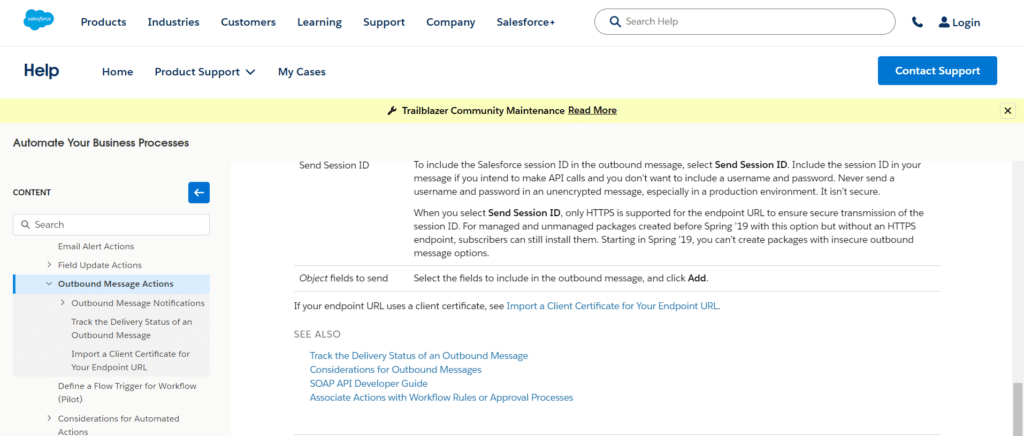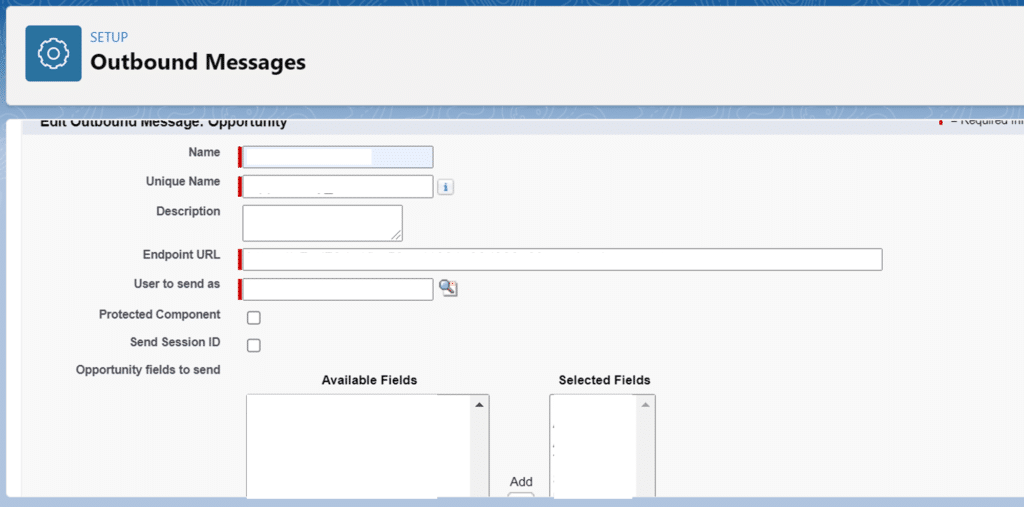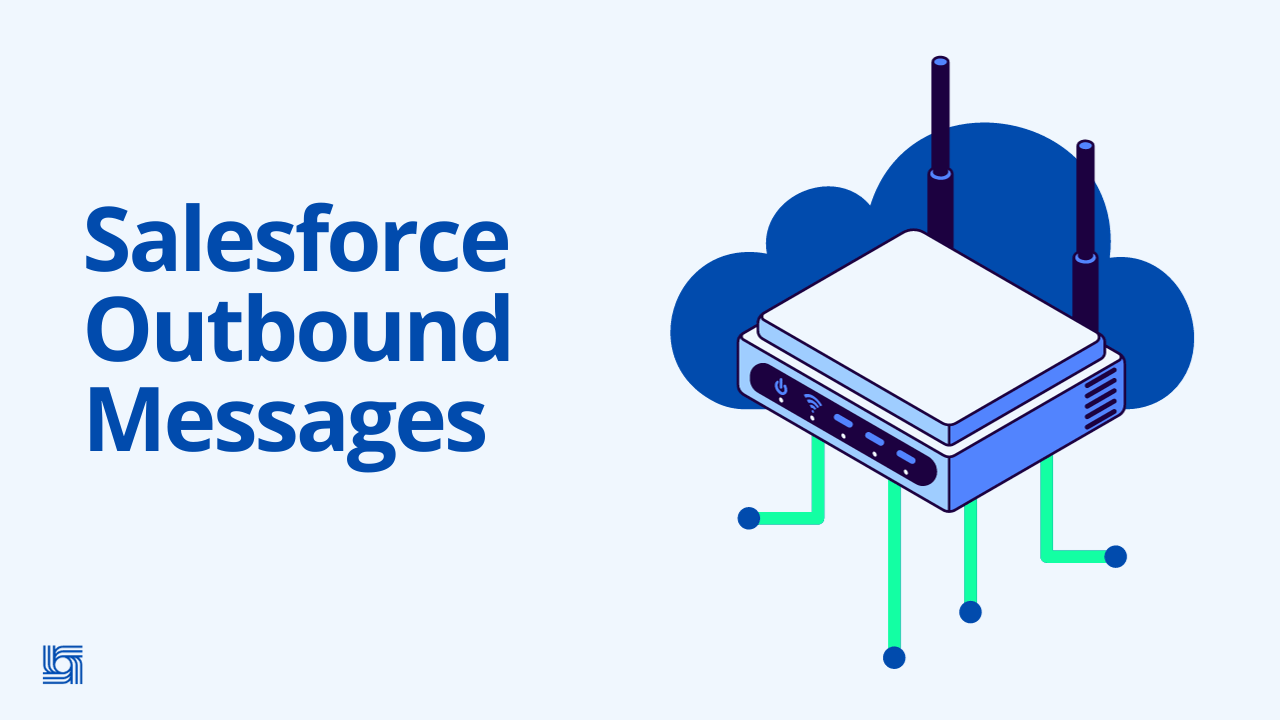Salesforce Outbound Messages: With outbound messaging, you may indicate that modifications to fields inside Salesforce may result in messages containing field values being sent to specific external sites. Salesforce’s workflow rule functionality includes outbound messaging. Workflow rules are designed to monitor particular types of field changes and initiate automated Salesforce activities, such as sending outgoing messages, creating task records, or sending email alerts.

Sending outbound messages from Flow is now possible. The likelihood of trying again will steadily decline as more attempts are made, and more are unsuccessful. Salesforce uses an XML answer in a specific format from a third party and a particular XML value to determine whether or not the message was delivered successfully.

We can see how outbound messages function in the salesforce in the figure that follows.
To begin, log in to Salesforce.org, which is represented by the user session. Next, apply a workflow rule to any object of your choosing. Finally, designate the workflow’s outgoing message as the action.
After processing across the internet and reaching the endpoint URL, this outgoing message will alter the other program. However, it will be recognized as a Soap Response. It therefore came down to how the outgoing message flowed.
Table of Contents
ToggleWhat is Outbound Messaging?
Nowadays, enterprises are embracing smartphones to reach more significant audiences because they improve the connection between people and enterprises. They frequently take this action to give their clients a human touch and personalize material for them.

The straightforward act of sending communications to a consumer without them contacting you is known as outbound messaging. Outbound messaging, with its 98% open rate, allows businesses to communicate with customers in a more personalized and tailored way.
As a declarative feature, Salesforce added outbound messaging to the Flow to streamline the process and improve personalization for increased customer engagement. In essence, this capability lets you combine Salesforce with other third-party platforms.
How can Salesforce assist in the creation of outbound messages?
Businesses can now automate customized communications with Flow by utilizing notifications and the SOAP API in a straightforward approach. It functions on the basis that Flow delivers a SOAP API message via channels like SMS, social media, etc., to an external system, such as a mobile phone, whenever a new or updated record is generated or changed in Salesforce.

A typical use case, for example, would be one in which, each time a new account is established or an existing one is updated in Salesforce, a new account record is updated in the backend system, such as an ERP, order management system, or logistics system.
This feature’s formal nature, which limits processing time to a maximum of 15 minutes, is its best feature. In essence, this would be a fantastic method for using Salesforce to link other systems, enabling companies to use this advantage and improve their single view of the customer.
How can I use Salesforce to send an Outbound Message?
Setting up outgoing messaging in the Salesforce environment involves two steps:
In the first stage, you must define the outgoing message, choose the object, fields from the thing, and endpoint URL. You need to specify what will cause this outgoing message to be sent in the next step. Salesforce has four functionalities that let you automate the creation and updating of records.

- Workflow Guidelines
- Salesforce Flow
- Process Builder
- The Apex Trigger
While Apex Trigger requires coding, the first three features—workflow rules, process builder, and Salesforce Flow—are declarative and don’t require coding. Salesforce Flow is the best option because Workflow Rules & Process Builder will be removed by 2023, according to Salesforce.
Use Case for Salesforce Outbound Messages
One typical application for processing outbound messages is synchronising any third-party system with Salesforce whenever a lead is converted, or an account record is generated, among other events.

An endpoint must be created before demonstrating the scenarios above for an outgoing message. Remember that none of the online tools will return an acknowledgement to Salesforce after receiving a message on the other end. Salesforce is compelled to conclude that the message was not successfully sent and will attempt to send it again.
Suggestions for using Salesforce Outbound Messaging
According to sales research, sending outbound messages might result in a 50% cost reduction compared to making voice calls. This indicates that businesses nowadays need to switch to a proactive messaging solution rather than waiting for the customer to contact them to increase ROI. However, would the level of engagement for every kind of outbound message be the same? Without a doubt. The following are some considerations that your company should make while distributing outbound messages to clients:
- Customize messages: Today’s consumers seek content that is tailored to them and helps them feel more connected to the company. A customized outbound message boosts customer support metrics and enhances engagement.
- Make the purpose of the communication evident by making a timetable or a map showing how effectively the message will be distributed. Once the value is apparent, you will know what to concentrate on when crafting communications.
- Ensure that messages are consistent: Verify that the message’s value is evident and constant. Customers may need clarification on inconsistencies and decide to unsubscribe.
- Verify the frequency: While sending out messages at regular intervals can keep a customer interested, sending them out too frequently or at strange times will quickly lose that interest.
- Efficient result analysis: Your sales and marketing teams can develop tactics to increase conversions by examining how customers respond to outbound messaging. Additionally, it helps to future-proof your business and boost earnings in the future.
- Please update your contact details frequently: Keeping contact details current lets companies give their clients more control over their views. Customers can start and stop receiving messages at any time by asking for permission and providing a simple unsubscribe option.
How To Set Up A Salesforce Outbound Messages
Step 1: Type “Outbound Messages” into the Quick Find box from Setup.
Step 2: Select the New Outgoing Message option.

Step 3: From the Picklist, choose an item.
Step 4: Complete all the fields that need to be filled in, including Name, Unique Name, Endpoint URL, and, if necessary, Available Field.
Step 5: Select the “Save” option.
Endpoint URL: The addressee will receive the message by the terminal URL. This terminal will receive a SOAP message from Salesforce.

Best Practices for Salesforce Outbound Messages:
Error Handling: To handle situations where the external system is unavailable or has problems when processing data, put robust error handling procedures in place. Tools for logging and monitoring can help find problems and fix them quickly.
Governor Limits: These constraints should be considered, mainly when working with substantial data. To maintain consistent performance and stay within these limitations, keep an eye on and optimize your outgoing message operations.
Documentation: Keep thorough records of all outgoing message configurations. This contains information on field mappings, endpoint URLs, and any custom logic used. For future use and troubleshooting, this documentation is priceless.
Conclusion
Salesforce Outbound Messages are a crucial bridge for integrating Salesforce with external systems, enabling businesses to achieve seamless data communication and automation. Organizations can harness the full potential of Salesforce Outbound Messages to streamline their CRM workflows and improve overall operational efficiency by knowing the essential components, benefits, and implementation best practices.
As businesses evolve, mastering such features becomes critical for staying competitive in customer relationship management.




